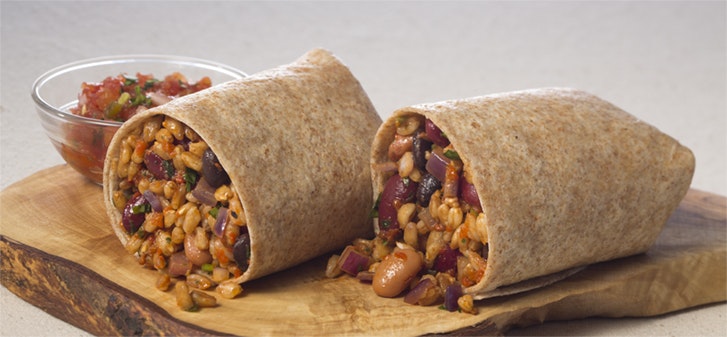
The resurgence of bean cuisine
Operators find a welcome audience for nutrition-packed chickpeas, beans and lentils.
Who knew that beans could mean so much to so many people?
The Food and Agriculture Organization of the United Nations has named 2016 the International Year of Pulses. The campaign was designed to call attention to pulses, which are part of the legume family and include dried peas, edible beans, chickpeas and lentils.
These items are not only nutritious, but they also offer economically accessible fare and contribute to food security. They even foster sustainable agriculture, as pulses can improve soil fertility and increase biodiversity.
Pulses have been gaining on menus, too — notably as the trend toward global cuisine gains traction. According to Datassential MenuTrends, the use of pulses in restaurants has been growing steadily over the past decade, up 151 percent in terms of menu mentions since 2005. Specific pulses like lentils are up 69 percent, while chickpeas have risen 290 percent on menus since 2005.
In addition, Datassential listed pulses as one of the top trends for 2016. Pulses fit perfectly with what the Chicago-based research firm calls the “Healthy 3.0” trend, which refers to the functional foods that offer energy, protein or are characterized as being superfoods. Pulses contain protein, fiber, vitamins and amino acids.
Increasingly, operators have been adding beans to dishes and also creating menu items revolving around bean- and pea-based foods. For example, Denver-based Qdoba Mexican Eats, which has 600 locations nationwide, last year launched Knockout Tacos®. The six variations feature warm corn or flour tortillas and what the company calls “bold and unexpected flavor combinations.” One of the selections is Bohemian Veg, which features shredded cheese, black beans, corn salsa, hand-smashed guacamole, salsa verde, minced onions, cilantro and cotija cheese.
“The Bohemian Veg taco was designed with the needs and wants of not only our vegetarian guests, but also those looking for a healthy, flavorful, meat-free offering,” says John Cooke, vice president of menu strategy and innovation at Qdoba Restaurant Corporation. “Beans are the basis of many of our offerings, including the Bohemian Veg, and we continue to innovate new flavor combinations. This allows our guests to select menu items that deliver a truly craveable experience.”
Burritos and wraps, in fact, have proven to be excellent vehicles for beans and other pulses. At Rubio’s, the nearly 200-location fast casual chain based in San Diego, black beans can be found in a number of bowls and burritos, including the Ancho Citrus Shrimp Burrito made with pan-seared sustainable shrimp. The dish is prepared with garlic, salt and Rubio’s signature smoky red chile sauce. “The beans enhance the unique flavor profile of the dish,” a Rubio’s spokesperson says. “Both our black beans and pinto beans are cooked in our kitchens daily from scratch, and are never fried or refried, which is becoming increasingly important among the more health-conscious consumers. Beans are also a great source of protein, providing additional menu options for vegetarians.”
Beans are indeed healthful, and vegetarians and omnivores alike are looking for the healthful and delicious properties of bean-based foods.
Hummus, which is made mostly of chickpeas, is especially popular because it's a food that has a story, says Melissa Abbott, vice president of culinary insights for The Hartman Group, based in Bellevue, Wash. “So much of it has to do with the interest in global and ethnic cuisines,” says Abbott, who predicts hummus will be the next Greek yogurt. “If you say this is an amazing cultural food that started in Morocco and Lebanon and Sicily, and you dive into all the fascinating aspects of food culture, that’s when you're going to get consumers to try things they might not have typically tried.
Another important trend Abbott cites is the growing interest among consumers in plant-based or vegetarian cuisine. “It is not relegated to a small percentage; this is mainstream,” she says. “We are seeing an interest in making different choices during the day. Consumers might forego meat until dinner or all day.”
It turns out that pulses are not only nutritious, but they also might make people smarter, one study suggests. The University of Massachusetts Amherst surveyed students who were on the meal plan and found that an increase in vegetable protein, which includes legumes, was significantly associated with an increase in their grade point average, or GPA. The more plant proteins students ate, the higher their GPA.
UMass Dining Services has increased the number of menu offerings of plant protein over the past few years. In the fall of 2009, UMass Amherst offered 10 menu items that featured plant-based proteins; by the spring of 2016 that number had risen to 105. Servings of whole grains also increased, from 31 servings in the fall of 2009 to 91 in the spring of 2016.
Pulses can often be found partnered with burritos and wraps on the UMass dining menus. For example, the Southwestern Salad — which can also be served as a wrap — contains black beans, mixed greens and Scarlett Butter lettuce, roasted corn, fresh avocado, sliced peppers and onions, and organic chipotle ranch dressing.
Other UMass menu items featuring pulses include Roasted Eggplant with Lentils, edamame, zucchini cakes with feta cheese and Greek yogurt; and Pistachio-Almond Cremee with pomegranate aquafaba, which is the canned bean liquid whipped up to create a meringue.
Pulses are definitely part of a growing trend, experts agree, whether served in a hummus wrap, a burrito or as a component in numerous other on trend meals and snacks. “We are seeing a resurgence of bean cuisine,” says Abbott of the Hartman Group. “There are a lot of global recipes that elevate the flavor.”
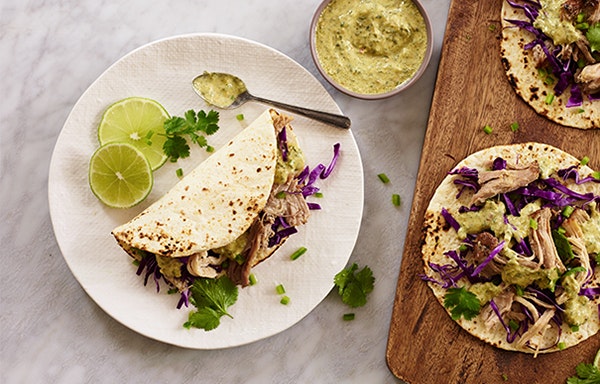
Hooking customers with fish tacos
Operators are meeting increased demand by menuing fish tacos with innovative ingredients.
Fish tacos are gaining in popularity, and not just among surfers and beach vacationers. Today these trendy handhelds have evolved into a favorite food for people seeking everything from a satisfying snack to a dining experience featuring premium seafood served with fresh ingredients in a tortilla.
“With tacos it’s such an easy thing for us to play with some fun ingredients,” says Jeff “JP” Roots, chef and co-owner of The Velvet Cactus in New Orleans and Baton Rouge, La. The restaurants offer fish tacos with grilled or fried tilapia, shrimp and other types of seafood.
The Velvet Cactus menu changes often and one currently popular fish taco is made with ahi tuna. The tuna is seared, diced and put in a corn, flour or wheat tortilla. It comes with avocados, sliced red onion, and a creole coleslaw that features local seasonings. It is topped with raspberry chipotle sauce and crumbled queso fresco.
The rising popularity of Mexican foods and love of spice have helped fish tacos gain a place on menus across the country, says Andrew Freeman, president of Andrew Freeman & Co. Restaurant & Hospitality Consultants in San Francisco. “And not just on Mexican restaurant menus. [You find them] on many new American menus,” Freeman says.
“Fish tacos offer a great option for sharing and are very popular on bar and snack menus,” he adds. “Whether it’s cod, mahi mahi or another white flaky fish, chefs look to source locally and keep the fish as seasonal as possible. Many chefs are also making their own hot sauces and salsas which accompany their fish tacos extremely well.”
Sauce it up
Sauces do indeed make a difference, says Steve Stoddard, chief executive of Pacific Catch, with seven locations in the San Francisco area. Pacific Catch offers fish tacos with both familiar and not-so familiar ingredients. The Traditional Baja is made with crispy Alaskan cod, cabbage, avocado-tomatillo salsa, and jalapeño tartar. The Mahi Mahi includes spice-rubbed mahi mahi, cabbage, avocado-tomatillo salsa and lime crema.
“We put a little twist on things,” Stoddard says. “I think there are opportunities to expand that with popular seafood choices and finding ways to infuse them into a unique creation. And that becomes your latest and greatest taco.”
For some operators, the latest and greatest taco involves blackened fish. Elliott’s Oyster House in Seattle serves Blackened Rockfish Tacos, which feature salsa mayo, shredded cabbage, white corn tortillas, chips and fresh red salsa. Elliott’s uses fresh locally sourced rockfish, which is dredged in blackening seasoning and then seared on high heat.
“Searing the rockfish on high heat is critical to seal in the moisture and caramelize the outside of the fish,” says executive chef Robert Spaulding. “We also flame-char the corn tortillas and then add tomatillo salsa aioli along with all of the other fresh, flavorful ingredients.”
Growler USA offers Blackened Mahi Tacos made with spicy mahi mahi, pico de gallo and southern-style coleslaw. It is garnished with fresh lime and sour cream, and served on a soft flour tortilla. The Centennial, Colo.-based microbrew pub has locations in Eugene, Ore., Charlotte, N.C., and Austin, Texas, and the food is designed to celebrate the flavors of the craft beverages.
Give them choices
Customization is also on-trend. The 27-unit bd’s Mongolian Grill offers fish tacos featuring hand-battered white fish tossed in bd’s sweet and sour sauce, with wasabi seed, bean sprouts, bok choy and Sriracha sour cream. The chain encourages guests to “Stir It Up, Your Way” and highlights its “Always Market Fresh” ingredients.
Patrons like being able to choose from an assortment of fresh ingredients to customize their fish tacos, says Princess Franada, chef at Flying Fish Restaurant + Bar in Seattle. The eatery offers the Talk-Of-The-Town Fish Tacos, with fresh fish trio, pickled onion, guacamole, roasted tomato salsa and corn tortillas. The food is served on a stainless steel platter.
“I think they are popular because people are able to use their hands to make their own,” she says. “You have the tortillas that are a staple for Mexican food, and you can put cheese in there, guacamole, the charred flavor of the salsa, pickled onions. All those flavors combined together — it’s like an explosion.”
Flavor, flavor, flavor
Fish tacos also can emphasize island flavors. At Coconut’s Fish Café, which is based in Maui, Hawaii, and has locations in California, Texas and Arizona, the Hawaiian-style taco is made with 17 ingredients and is the most popular menu item. “If we were going to create a fish taco, I wanted to avoid Mexican flavors, which is why our fish taco consists of island flavors,” says Michael Phillips, founder and chief executive. “The taco is made with grilled mahi mahi and ono on two white corn tortillas with a bit of cheese, topped with organic red tomato salsa, Coconut’s Fish Cafe’s signature coconut milk-based coleslaw, fresh tomatoes and fresh mango salsa. The fish is sustainable and wild-caught.”
Other operators say customers want the flavors of another region. “Big Star's Taco de Pescado brings the Baja California style to our Chicago area,” says Big Star’s chef de cuisine, Julie Warpinski. “Following the region's love of fried fish tacos, ours is a Tecate-battered tilapia topped with spicy chipotle mayonnaise, lime marinated cabbage slaw on a housemade corn tortilla. It's the perfect balance of spice, acidity, and crunch — and is meant to pair with margaritas on our patio.”
Fine-dining restaurants are also menuing fish tacos. George’s At The Cove in La Jolla, Calif., offer a tasting menu, which includes a fish taco of achiote-cured snapper, avocado, roasted pineapple-jalapeño salsa, cabbage, cilantro and chicharon made with the fish skin. “People say it's the best fish taco they have ever had,” says executive chef Trey Foshee. “We are in San Diego, and I thought it would be fun to include a fish taco for our extended tasting menu. Something to break up the more serious dishes and something you can eat with your hands.”
Be innovative
Meanwhile, Amy Myrdal Miller, president of Farmer's Daughter Consulting, Inc., in Carmichael, Calif., says the industry should expect continued innovation when it comes to fish tacos. For example, more restaurants are trying grilled shrimp, grilled salmon and grilled halibut, she points out.
“The one wish I had, however, is that more chefs would pay more attention to the creamy component,” she says. “Sriracha mayonnaise or a crèma is easy, but I’d like to see more development on the cabbage/coleslaw component. More chiles, more heat, more cilantro, greater variety of vegetables in the coleslaw.”
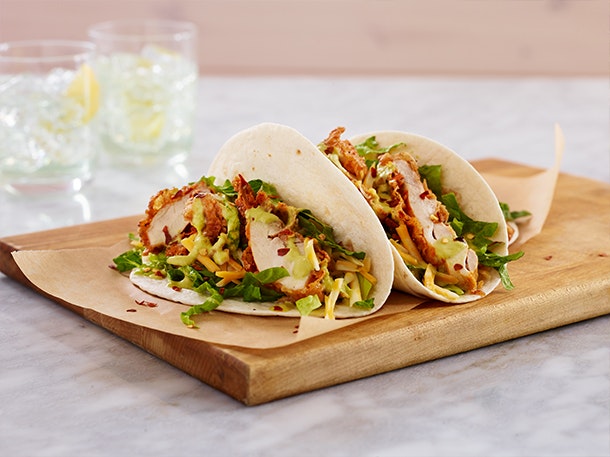
Tacos, the sandwich of the new millennium?
Taco fusion is taking off and restaurants are experimenting with a mélange of flavors.
America’s love affair with tacos has led to a second act — offering fans of Mexican cuisine the opportunity to experiment and revel in tacos fused with a variety of flavors, textures and ethnic interpretations.
Chefs are leading the way with a host of creative offerings that take taco fusion to a whole new level. At Fusion Taco in Houston guests can enjoy such delights as Tempura Local Shrimp Taco, with wasabi aioli and napa slaw as well as Asian August Steak Taco featuring black beans, grilled onions, ginger chipotle BBQ sauce. At Garbo’s Grill in Key West, Fla., patrons are embracing the Atlantic Coast’s flavors such as jerk chicken and tropical fruit. One taco that comes highly recommended by Travel + Leisure magazine is the Cayo Fish Taco, featuring mahi mahi, mango, jalapeños, cabbage and a Caribbean sauce.
Andrew Freeman, president of Andrew Freeman & Co., a San Francisco-based restaurant and hospitality consultancy, says the taco fusion trend is a natural evolution. “Every culture and cuisine has a filled item of deliciousness, and what’s not to love about that? Chefs continue to delight in the pleasures of the familiar and always delicious foods of the world.”
Lynda Yi, a Korean immigrant moved to Las Vegas 11 years ago with her husband and took over her father-in-law’s Mexican meat market and deli. The couple loved Mexican food but tired of eating it 24/7 and began experimenting with Korean barbecue meats as fillers. Her fusion of Korean and Mexican has since taken off under the moniker KoMex.
“Taco Fusion — it's a long-running trend that offers chefs a platform for creativity. Notable examples include any of the tacos on offer at the Kogi BBQ taco trucks, the seminal operation that combines Korean and Mexican ingredients like Short Rib Tacos with kimchi,” says trends expert, Nancy Kruse, president of the Atlanta-based Kruse Company.
Barbecue fillers have expanded beyond just Korean restaurants as operators nationwide are stuffing tortillas with myriad ingredients. At Chicago’s Nacional 27, a BBQ’d Lamb Taco with Organic Agave and avocado salsa is offered for $4.95, and Mexique in The Windy City features a Coffee Braised Lamb Barbacoa taco, which fuses flavors of Mexico and France.
Amy Myrdal Miller, president of Farmer’s Daughter Consulting, a culinary and nutrition communication firm, notes taco fusion is a national trend and not limited to the major cities, or East or West coasts. “I just ate a Vietnamese pork banh mi taco with pickled vegetables on top at a bar in Fargo, N.D., last weekend, so taco creativity is not limited to the coasts.”
Maeve Webster, president of Menu Matters and trends expert, says the possibilities are endless when it comes to the fusion of creativity with tacos. “Tacos, in many ways, are the sandwich of the new millennium,” Webster says. “But because tacos aren't 'traditionally' American or have any level of nostalgia or pre-conceived expectations, there's greater room for experimentation.”
She stresses, however, that with the sophistication of the American consumer’s palate, authenticity is crucial.
“The key to a successful fusion offering is that each element maintains its authenticity,” Webster says. “If the individual items lose their authenticity it becomes less of a fusion and more of a mish-mash. If an operator says it’s offering a taco with kimchi, that kimchi has to be as authentic as possible (barring it being described as some type of kimchi-inspired sauce) as consumers — particularly younger consumers — are either far more familiar with these elements or are going to look them up.”
Jesse Gideon, executive chef and chief operating officer of Atlanta-based fast-casual chain Fresh To Order says the taco is a great platform for creativity.
“Instead of thinking of a taco as a taco; think about it as a platform to easily transition food from plate to your mouth,” he says. “So items that would generally fall apart or be overly messy in your hands can now safely and cleanly reach their final destination.”
Aside from experimenting with cuisines and flavors, chefs also can menu tacos in multiple portion sizes. A case in point is The Skylark in New York.
“We offer three sizes of tacos,” says Alison Awerbuch, partner at The Skylark. “For cocktail receptions or semi-private events in our lounge we do single-bite tacos that are butler-passed to guests. For our lounge menu we do three or four-bite tacos. When we want to offer something heartier we do a presentation of two to four-bite tacos with two different fillings served together in individual bamboo boats with several salsas, chipotle-dusted jicama and grilled pineapple. These are mini meals.”
Taco fusion is evident in high-end restaurants as well as food trucks nationwide.
At Copita Tequileria y Comida in Sausalito, Calif., executive chef Daniel Tellez experiments with ingredients in his crowd-pleasing taco offerings. “At Copita, I have a Lobster Taco on the menu with black beans and butter poached lobster. The taco is an interpretation of the classic Rosarito lobster in Mexico that is served with black beans and tortillas,” he says. “Also, our Baja Style Fish Taco, which is one of the most popular tacos in Mexico, is served with battered cod and an avocado Parmesan and wasabi aioli, with petite seagrass on the slaw.”
On the other end of the spectrum Valentina in Austin, Texas, is earning legions of fans for its Smoked Brisket Taco. The taco trailer fuses the best of the Lone Star state in a taco of tender smoked brisket, guacamole and tomato Serrano salsa on a fresh flour tortilla.
At Torchy’s Tacos, a 38-unit fast-casual chain, the company experiments on a monthly basis. “We do a Taco of the Month. Sometimes it has a seasonal flair: For example in July we serve a taco called the American; November is a turkey taco; and in December we have a lamb taco,” says director of culinary, Cheryl Drummond. “For our Taco Of The Month we sometimes have contests within the company to see if managers can come up with an interesting taco.”
But Webster sounds a note of caution when it comes to taco fusion experimentation.
“To make fusions really successful they should focus on only two cuisines, three at most,” she says. “More than that it becomes hard to balance the flavors and to focus the innovation. With fusions, more is usually not better. It just ends up being too much.”
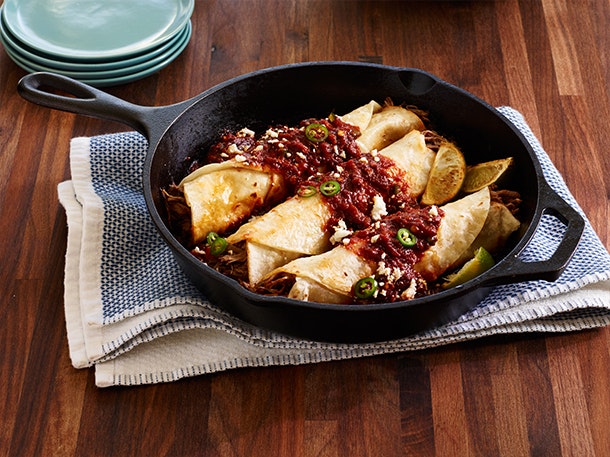
Finding fire and flavor, beyond sriracha
Chefs, restaurateurs move beyond the popular sauce in their culinary quest for fire.
Few flavors have captivated American palates in the past decade like pepper sauces. Whether those sauces are rooted in Mexican, Korean or Middle Eastern recipes, restaurant customers have demonstrated a collective yearning for a flavorful burn.
Based on that trend, U.S. chefs are seeking fiery and flavorful attributes from other sources. Be it harissa paste from Morocco, aleppo peppers from the Middle East or bird chiles from Thailand, flavor and fire are finding their way into myriad meals at American restaurants. Chains such as Jimmy Buffett’s Margaritaville ratcheted up the heat by featuring Tabañero Hot Sauce on the table and in dishes such as its taco burger and signature bloody Mary.
Though best known for its fried chicken, Popeyes Louisiana Kitchen sold a Wild Pepper Tenderloin LTO last fall that was marinated in habanero pepper, aji amarillo and Szechuan peppercorns. Noodles & Company announced it will roll out Korean meatballs with gochujang chile paste this year. That same pepper paste can be found in foods sold over Southern California food truck counters where Korean BBQ (on the bone, pulled for tacos or stuffed into spring rolls) headlines the menu.
Chefs serving chicken wings have moved well beyond the liquid lashing of mere buffalo sauce by using Indian masala sauce, and harissa enriched with mole to deliver internationally diverse sources of heat.
At a regional Mexican chain in the Southeastern U.S., Fall marks the arrival of an annual chile festival reflected in a special menu of burritos, tacos, enchiladas and more stuffed with flame-roasted and chopped bits of spicy green Hatch chiles from New Mexico.
Eager to ride the red-hot coattails of the burgeoning Nashville hot chicken trend, KFC launched its own Nashville Hot product this year. The dish includes the Colonel’s Original Recipe chicken drizzled with a spicy sauce and garnished with pickles.
Even Captain D’s, which is based in Nashville, began playing with fire when testing Nashville Hot Fish in Jacksonville, Fla., and St. Louis, Mo., last year. According to Jason Henderson, the chain’s vice president of product innovation, its cornmeal-style breaded whitefish is spiced up with Cajun seasoning, fried and then glazed with spicy oil.
“Buffalo’s had its day and Cajun is sticking around, but Nashville has finally had its break,” Henderson says.
At Zentan, an izakaya restaurant in Washington, D.C., executive chef Yo Matsuzaki combines red and green yuzu peppers with wasabi oil to bring aroma and heat to a dish of braised short ribs and oxtail. He uses a compound butter spiced with red yuzu pepper and shallots to add body and warmth to steamed mussels, and he laces his sashimi salad with wasabi oil.
Five-unit, New York-based SUSHISAMBA layers multiple hot spices into its sashimi and sushi, such as a Japanese fermented pepper paste called tobanjan — used in spicy aioli over crispy rock shrimp; momiji oroshi, a grated pepper puree in a wagyu gyoza dipping sauce; and rocoto, a fiery Peruvian pepper used in a tuna seviche marinade.
At Big Jones in Chicago, chef-co-owner Paul Fehribach sneaks heat into his Southern menu where possible. He rubs his smoked meats with modest amounts of cayenne and black peppers, but his sauces are designed to bring some sizzle to the palate.
Fehribach makes a pick-a-pepper sauce using cider vinegar and heirloom hidalgo peppers, which he says are sweeter and smokier than serranos.
“Then, when we make a beurre blanc, and rather than reaching for wine vinegar, we’ll use that pepper vinegar, which adds a little bit of red tint to the sauce,” he says.
To make his signature house hot sauce, he braises multiple chiles in apple cider vinegar, garlic, onions and carrots for four hours and then purees them.
“We’ll add that to our barbecue sauces and our honey hot sauce,” he says. “I also add that to tomato paste, sorghum molasses, mustard and Worcestershire for our ribs.”
Nir Mesika, executive chef and partner at Timna in Manhattan, makes harissa based on recipes learned in his homeland of Israel, but he confesses the secret ingredient is a little sriracha.
“I roast red bell peppers on an open flame, take the seeds out and grind them with garlic and put them in a pot with canola oil over low fire for three hours,” he says. When finished, he adds cumin, smoked paprika, soy sauce, white vinegar, olive oil and a little sriracha. “We brush it on grilled skirt steak. It’s a little bit picante, but not really hot. I don’t like food that you eat and you start crying.”
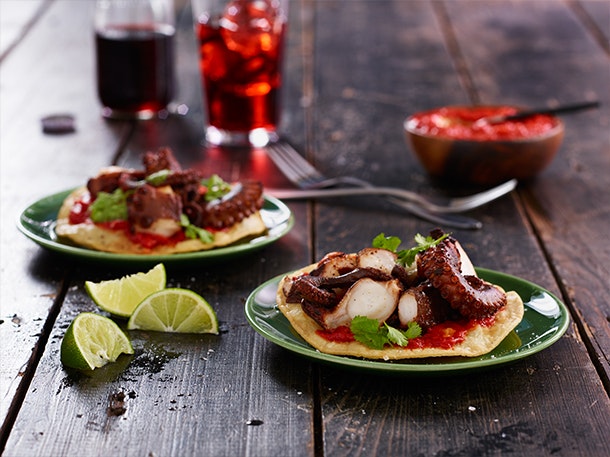
Americans embrace modern Mexican fare
Chefs and operators offer more authentic, regional dishes from south of the border.
Mission / February 2016
Americans' appreciation of Mexican cuisine has advanced dramatically in recent years, progressing beyond the bounds of such traditional Tex-Mex staples as tacos and burritos to a more modern adaptation of authentic dishes that emphasize sophistication, regionality and freshness.
“There’s no longer one view of Mexican cuisine,” says Amy Myrdal Miller, president of Farmer’s Daughter Consulting, a culinary and nutrition communication firm.
“Foodservice operations are looking at regional Mexican cuisine and featuring more authentic dishes,” she says. “An example is the seafood culture of Veracruz or the street tacos of Mexico City that we now see in U.S. restaurants featuring Mexican food.”
American consumers’ attitudes toward Mexican cuisine have come a long way since the 1950s. No longer are the dishes of Mexico considered too spicy or hot. As regional, authentic dishes have made their way onto American menus there has been a seismic shift in our collective culinary view.
As Americans’ palates have grown more sophisticated, Mexican destinations have spiked curiosity about flavors and dishes indigenous to its various regions.
“Mexico City is probably the most exciting food city in the world right now,” says Joanne Weir, the star of “Joanne Weir Gets Fresh” on PBS and author of “Kitchen Gypsy: Recipes and Stories from a Lifelong Romance with Food.”
“It has an incredibly vibrant food scene,” Weir says. “We have also experienced a larger percentage of Hispanic cooks, and I think there is more adventurous travel to remote regions in Mexico that is increasing demand — not to mention more availability of obscure Mexican ingredients.”
One consultant and restaurant owner in Austin, Texas, says a big reason Americans have a newfound love affair with Mexican cooking is that the quality has improved tenfold.
Traditional Mexican cuisine is very sophisticated, and what Americans are seeing now is better executed cooking, using better quality products. What was commonly seen in the American market previously was poorly executed Mexican cooking where the rules were cheap, spicy and greasy.
Chefs who are serving Mexican cuisine now have more knowledge — they have studied more. In addition, patrons have had more opportunities to travel and do research. “The offerings have changed dramatically,” says the consultant of a prevalent Mexican restaurant in Austin, Texas.
In recent years authentic Mexican cuisine has even begun to find its way onto the menus of America’s quick-service chains.
“The fact that we were able to introduce ‘street tacos’ to our menu a few years ago says a lot,” says the chief operating officer of a 160-unit operation that serves Mexican fare. “The idea was inspired by the food carts we found on the streets of Mexico City.”
“We loved the freshness and portability of serving three packs of tacos on smaller 4.5-inch corn tortillas,” says the COO. “It was a foreign thought to Mexican fast-casual and QSR menus at the time. Yet it has quickly become a top-selling platform that we are looking at expanding.”
A popular casual restaurant in Brea, Calif., adapts the culinary heritage of Mexico and Latin America, and has likewise moved beyond stereotypical Mexican fare.
The owner says one of the biggest influencers in the proliferation of modern, authentic Mexican cuisine has been the influx of Hispanic cooks since the 1970s and 1980s.
The biggest influencer began with the Mexican immigrant working in kitchens throughout the country back in the '70’s and early '80’s. They brought their culture into the restaurants by cooking family recipes from the different regions of Mexico where they were from.
However, chefs then discovered new chiles and produce that were only sold in Mexican/Latin stores in their neighborhoods, and they taught us ways to cook dishes Americans had never heard of before. Now there are second- and third-generation Mexican chefs that are going back to their roots and discovering new dishes that are outstanding, fresh, healthy and exciting.
It is these healthier ingredients and cooking methods that also mirror the top food trends embracing all types of cuisines gaining popularity in the United States. “Consumers want higher quality, ‘better-for-you’ menu options that provide a sense of culinary adventure,” says Myrdal Miller.
“There are many examples of Mexican restaurants putting more healthful, authentic options on their menus. Traditional Mexican cuisine is a healthy, plant-based cuisine that uses more expensive ingredients like animal-based protein in smaller amounts,” she says.
“Produce is used extensively. Tomatoes, corn, and chiles are the foundation of many Mexican dishes,” Myrdal Miller says.
Andrew Freeman, president of Andrew Freeman & Co., a San Francisco-based restaurant and hospitality consultancy, says the Mexican culinary evolution will continue to move through all restaurant categories.
“The world at large is much more aware of the quality of the food they are eating. If you couple this with the evolution of Mexican food, I predict we will see these influences in all Mexican restaurants from the neighborhood taqueria to the fast-casual chains,” he says.
PBS’ Weir likens the development of authentic Mexican cuisine to the evolution of Italian food in the United States. “The same exact thing happened with Italian food. People thought Italian food was spaghetti and meatballs,” she says.
“Now it is happening with Mexican cuisine in a big way,” she continues. “It is becoming elevated from what we used to think of as typical fare — burritos and tacos. Italian food used to be thought of as a cheap way to eat and so was Mexican, but clearly that’s not the case anymore.”

 Fry-Ready™ Tortillas
Fry-Ready™ Tortillas
 Flour Tortillas
Flour Tortillas
 Smart Hearty Grains™
Smart Hearty Grains™
 Wraps
Wraps
 Mazina® Tortillas
Mazina® Tortillas
 Corn Tortillas
Corn Tortillas
 Unfried Chips and Strips
Unfried Chips and Strips
 Chips and Taco Shells
Chips and Taco Shells
 Mission Super Soft™ Corn Tortillas
Mission Super Soft™ Corn Tortillas